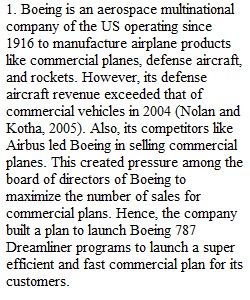


Q Case: Boeing 787: The Dreamliner by Richard L. Nolan and Suresh Kotha (available thru the Harvard Coursebook that you have to purchase) Citation: Nolan, R.L. and Kotha, S. (2005). Boeing 787: The Dreamliner. Boston: Harvard Business School Publishing. 18 Pages. 9-305-101. Boeing dominated the commercial airline manufacturing business since bringing out the first commercial airline jet airliner. But in 2005, it delivered fewer new planes than its fast-moving competitor, Airbus. Boeing responded by transforming its manufacturing business and introducing the first "all-composite" commercial airplane: the 787 (the Dreamliner). In addition to being a revolutionary new commercial airliner, the 787 attempts to change the large "spoke-and-hubs" airport operation to nonstop travel between many new "city-pairs" worldwide. Learning Objective To understand contemporary competitive strategy, required business transformation, and dynamic risk management. Prompt: Assignment description: Each student will answer the following questions. Students should limit their responses to information they ‘gleen’ from the readings as well as any relevant current events (don’t spend a lot of time finding current events – 99% of the ‘details’ / information will be in the readings. If you do additional research – which is always encouraged (in every course) - seek out research sources through the Steely librarians (online) as well as consider performing extensive research online with regard to the questions. In addition, a number of universities have information sources which may be helpful (and free). Students are not expected to pay for information. If you are having difficulty seeking information, contact the instructor for assistance. Once again, all the relevant information is available in the Harvard Coursebook collection that you purchased. You should not need to seek outside (of the Harvard Coursebook) information. Students should plan on writing at least 1000 words – with 7 questions to answer this should not be a challenge. This assignment is due no later than 23:59 EST on Sunday of Week 4 and must be submitted via Canvas. Questions to answer: (use questions #’s or headings to separate your answers) 1. Does Boeing’s strategic approach shifting from a supply-side to demand-side go-to-market make sense? 2. Do you think that Boeing’s decision to acquire McDonnell Douglas was a good one? What do you see as the pros and cons of this decision? 3. Did Boeing take its eye off its core commercial airplane business by not bring out a new airplane for more than a decade succeeding market leadership to Airbus? Is it likely Boeing can regain industry leadership? 4. Is the 787 appropriately positioned in the marketplace with a high likelihood of success? Why? Why not? 5. Are there deep roots to the disarray in CEO leadership, or do you think it is just random? 6. What competitive response should you anticipate from Airbus? 7. Is Boeing creating its own new competitors from Japan and China? Is this inevitable? Is it the right course of action? Instructions: 1. All posts should be done by 23:59 EST Sunday of Week 4. 2. References and 'proper' academic style citing of the references are required. Points will be lost by a lack of references or the improper citation of references. Points will not be gained by proper use of references or citations. They are expected to be utilized. The references most likely will be from one of the articles in the Harvard 1. Remember: Interactions are in writing – business style or essay style are acceptable. 2. A majority of your text in bullets is not acceptable. Grading Rubric Your assignment will be graded according to the grading rubric. Rubric Assignment Rubric Assignment Rubric Criteria Ratings Pts This criterion is linked to a Learning OutcomeCommand of Learning Materials 55 to >49.0 pts Excellent • Shows thoughtful, analytical interpretation of module materials and/or case content. • Demonstrates significant original thought that goes beyond the obvious. • Explicitly references module or case materials relevant to analysis. 49 to >42.0 pts Acceptable • Relies primarily on summarizing module materials and/or case content. • Demonstrates some original thought. • Does not explicitly reference module or case materials relevant to analysis. 42 to >0 pts Not So Good • Little or no connection to relevant module learning materials or case content. • Demonstrates no original thinking. 55 pts This criterion is linked to a Learning OutcomeResponse to Assigned Task 55 to >49.0 pts Excellent • Addresses all aspects of the assignment prompt or case question(s) fully, in appropriate depth and detail. 49 to >42.0 pts Acceptable • Addresses most aspects of the assignment prompt or case question(s) but misses a small part. OR • Addresses all aspects of the assignment prompt or case question(s) but lacks appropriate depth or detail. 42 to >0 pts Not So Good • Non-responsive to significant aspects of the assignment prompt or case question(s). OR • Content not relevant to the assignment prompt or case question(s). 55 pts This criterion is linked to a Learning OutcomeWriting Quality 40 to >36.0 pts Excellent • Clear, concise, and compelling. • Well organized thoughts. • Appropriate paragraph format. • No grammatical or mechanical errors. • Follows all assignment format instructions (e.g., document length). 36 to >30.0 pts Acceptable • Very minor difficulty in understanding content. • Somewhat disorganized thoughts. • Lack of appropriate paragraphing. • Minor grammatical or mechanical errors. • Some assignment format instructions not followed. 30 to >0 pts Not So Good • Significant difficulty in understanding content. • Extremely disorganized thoughts. • No paragraphing. • Multiple grammatical or mechanical errors. • No assignment format instructions followed. 40 pts Total Points: 150 PreviousNext
View Related Questions